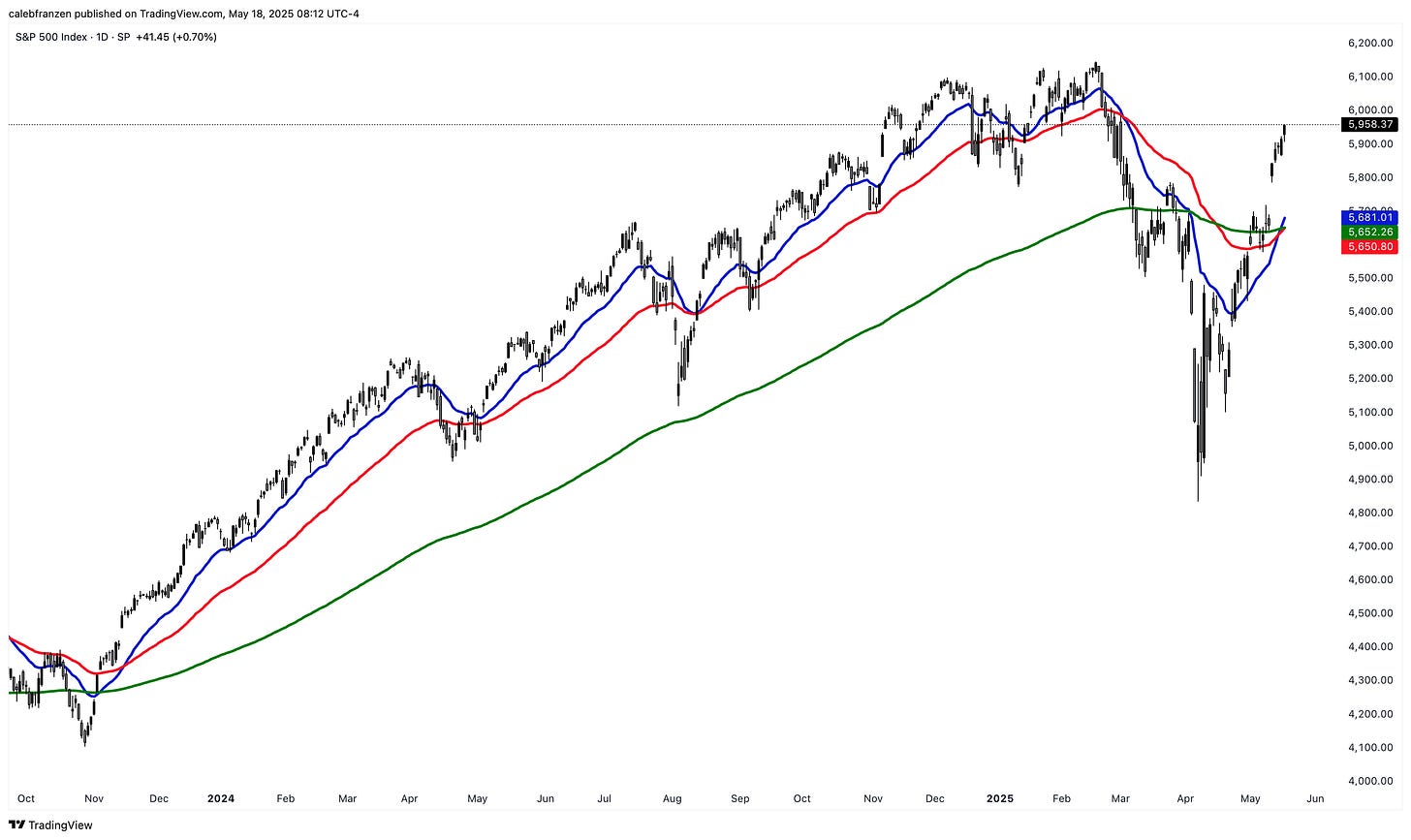Investors,
Under extraordinary events, the S&P 500 is making a “V-Shape” recovery.
The index is now up +23.18% from the lows on April 7, 2025 and only +3.15% away from making fresh all-time highs, something that most (including myself) thought was practically impossible.
But here’s what I did think was possible…
In April, I believed that the S&P 500 would show bullish characteristics once it reclaimed its moving averages, notably the following daily EMAs:
🔵 21-day EMA
🔴 55-day EMA
🟢 200-day EMA
I told investors in March, that this breakout would flip me back into a bullish stance.
Since that breakout on May 1st, the index has gained +5.6%.
In other words, the S&P 500 has “stuck the landing”.
Why was this my bullish criteria?
Just look at the chart above!
If uptrends are characterized by the price of any asset trading above its moving averages, then all we had to do for confirmation of an uptrend was wait for this breakout.
Trump? Doesn’t matter.
Tariffs? Doesn’t matter.
China? Doesn’t matter.
Rate cuts? Doesn’t matter.
Price is the only thing that actually pays.
It’s why my defensiveness in February & March was solely based on price action.
If you asked 100 different economists and market strategists about their opinion on tariffs and/or Trump’s policies or how China would (or wouldn’t) retaliate, you’d get 100 answers.
Opinions are dirt cheap, reflecting subjective beliefs and biases.
But price is the only truth that we have, recognizing that we can adapt and adjust our expectations depending on how price itself (and its indicators) evolve!
Maybe the initial signal from price was wrong…
If/when that becomes apparent, we can only hope to align with the new signal.
It’s okay to be wrong.
It isn’t okay to stay wrong.
You could (rightfully) make the case that my bearishness in April was wrong.
In fact, that’s something that I publicly acknowledged!
But, you could also (rightfully) make the case that my bearishness in March was right.
So which one was it? Was I right or wrong?
I was both!
Eventually, as market participants, we are always wrong.
Michael Jordan missed game winners.
Tiger Woods missed putts.
Steph missed open threes.
Barry Bonds struck out.
Napoleon lost battles.
Paul Tudor Jones got stopped out.
The biggest winners in history made errors and lost.
I’m certainly not comparing myself to these legends, but I think that every successful investor must be comfortable with the risk of being wrong & taking losses.
If we’re going to step into the arena and compete in the market to solve an ever-changing and complex puzzle, we must be willing to swing and miss in the pursuit of getting on base.
So where do we go from here, recognizing that our assessment might be wrong?
It’s simple, really…
So long as the S&P 500 stays above its 21, 55, and 200-day EMAs, I’m bullish.
Here’s that same chart from above one more time to refresh your memory:
Again, it’s usually a good idea to be bullish during uptrends…
And all uptrends in history are characterized by price > EMAs…
Then I’m going to be bullish during periods where this dynamic is provably true!
If we’re going to give ourselves the best chance at success in the market, then we can simply understand how to quantifiably diagnose the trend and then reverse engineer how to position ourselves within a market environment that rewards investors for being allocated.
I don’t know about you, but I learned that it’s best to own assets in uptrends…
And that owning assets in downtrends was a sure-fire way to go broke.
Since I have no intention of going broke and only doing everything that I can to get rich in the market, I’m going to do my best to align myself within uptrends.
It’s really that easy.
This isn’t rocket science.
There’s no need to overcomplicate it.
Analysts will often use big words, fancy language, and complex theories with an explicit intention of confusing their audience, then selling them the solution via a course.
They create their demand with a charade.
I’m telling you how to use basic principles to improve your odds of success.
If that’s valuable to you and you’re comfortable with the risk of being wrong in the short-term at the “cost” of ensuring your long-term success, it’s time for you to upgrade your membership and join the 1,070+ investors who are on a premium membership.
You’ll immediately unlock this report.
You’ll immediately unlock all past & future reports.
You’ll immediately get access to future livestreams for premium members.
You’ll immediately know every single holding in my long-term portfolio.
You’ll get real-time updates about what I buy/sell and why.
You’ll immediately improve your chance at success.
Now, let’s get into the alpha…
My Most Likely Scenario:
As we think about scenarios and potential outcomes, this path for the S&P 500 seems extremely reasonable, if not probable, to me.





